Taking Advantage of Spare Battery Capacity in Cellular Networks to Provide Grid Frequency Regulation
Abstract
1. Introduction
2. Background
2.1. Frequency Regulation in Modern Power Systems
2.2. Frequency Regulation Market
2.3. Battery Characteristics of BSs
2.4. Battery Degradation Model
2.5. Cellular Network Providing AS
- Decide prior to the bidding, day-ahead, the most profitable time-slot to bid.
- Select, during the intra-day period, according to the grid request, the most efficient cluster of BSs (the answer is made up of one entity) and manage its infrastructure efficiently.
- Maintain, during the intra-day period, the quality of service (QoS) provided by the cellular network and the required energy storage capacity for both the utility service and the backup power of the BSs (in case of a power outage).
- Minimize the activation delay of the selected BS cluster thorough the minimization of the BSs cluster range.
3. Literature Review
4. Problem Statement
4.1. Controlling the Power Flow Using the Battery System of BSs
4.2. Cluster Formation and Synchronization
4.3. Problem Definition
5. Decomposition Model
5.1. Master Problem: Base Station/Battery Configuration
| = reduction in energy grid consumption (obtained by supplying BS b partially or totally with its battery) in time period t (during up-regulation request); | |
| = energy drained from the grid and stored in the battery of BS b in time period t (during down-regulation request); | |
| = battery degradation rate of BS b in time period t. |
5.2. Parameters
- B: set of base stations, indexed by b.
- T: set of time-slots t within a market day.
- : set of electric zones, indexed by a.
- : clearing FCR price at hour t.
- : penalty FCR price at hour t.
- : sum of FCR up-regulation request at hour t.
- : sum of FCR down-reg. request at hour t.
- : ability of the battery of BS b to absorb energy.
- : ability of the battery of BS b to discharge energy.
- : battery replacement cost of BS b.
- : battery capacity of BS b.
- : battery max charge level of BS b at time t.
- : battery min charge level of BS b at time t.
- : initial battery charge level of BS b at time t.
- : power consumption of BS b during hour t.
- : neighborhood of base station b. Each is formed by the k nearest BSs to b (k is also a parameter).
- : distance (in meters) between BS b and .
- and : weight values of the last two components of the optimization objective.
- : agreed power bid value.
5.3. Variable Definition
- : 1 if configuration is selected; 0 otherwise.
- : 1 if base station b is participating in the bidding as a primary BS; 0 otherwise.
- : 1 if base station b is participating in the bidding as a backup BS; 0 otherwise.
- : 1 if base station b is participating in the bidding as a primary BS during time period t; 0 otherwise.
- : 1 if base station b is participating in the bidding as a backup BS during time period t; 0 otherwise.
- : 1 if t is the most profitable time for bidding participation; 0 otherwise.
- : 1 if some base stations are selected for bidding participation in electricity area a; 0 otherwise.
- : cluster diameter.
5.4. Optimization Model: One Bidding Hour
- The overall FCR-UP and FCR-DOWN contribution per hour of time:
6. Solution Scheme of the Decomposition Model
6.1. Pricing Problem: Generation of Hourly FCR Pattern for a Given Participating BS
- Variables
| = the state of charge of the battery of the base station under consideration after the FCR event e. | |
| = the reduction in energy grid consumption (obtained by supplying the BS under investigation with its battery) for the FCR event e. | |
| = the energy drained from the grid and stored in the battery of the BS under investigation for the FCR event e. | |
| = the battery degradation rate associated with the current time t (see Section 6.2). |
- Example: Consider a given BS b during time period t and a set of FCR events . At the end of time t, the output of the lower-level pricing can be represented by t ⇝, and .
- Objective: Reduced cost
- A non-zero FCR event is associated with either upward or downward regulation. Thus, the set E can be represented byIn addition, assume that , where is an artificial event that contains the initial state of charge of the battery of BS b. Also, denotes the SoC value at the end of the previous FCR event.
- Updating of SoC value:Participation in FCR down-regulation events:Participation in FCR up-regulation events:Variable bounds:
6.2. Battery Degradation
7. Numerical Results
7.1. Frequency Dataset
7.2. Simulation Setup
7.3. Experiment I (FCR-N)
7.4. Experiment II (FCR-D)
7.5. FCR Potential and Scaling Up CSP Participation
8. Conclusions
9. Future Work
- (i)
- Development of algorithms (e.g., machine learning) to predict, a day ahead, all required input values.
- (ii)
- Finding a faster but still efficient optimization method, e.g., heuristics, especially for cases of several BSs.
- (iii)
- Investigating similar optimization methods for other FR services such as fast frequency reserve (FFR).
- (iv)
- Investigating a new approach to automatically identify and select the most profitable FR service for each hour.
- (v)
- Investigating the impact on CSPs’ FR operations and profits when equipping BSs with a renewable energy source (such as solar and/or wind).
Author Contributions
Funding
Data Availability Statement
Conflicts of Interest
Nomenclature
| Acronyms | |
| ASs | Ancillary services |
| BSs | Cellular base stations |
| BESS | Battery energy storage system |
| CSP | Communication service srovider |
| D-1/D-2 | One day ahead/two days ahead |
| DSO | Distribution system sperator |
| DoD | Battery septh of sischarge |
| ENM/OSS | Ericsson Network Manager/Operation Support Systems |
| FCR | Frequency Containment Reserve |
| FCR-D | Frequency Containment Reserve for Disturbances |
| FCR-N | Frequency Containment Reserve for Normal Operation |
| FR | Frequency regulation |
| ILP | Integer Linear Programming |
| MILP | Mixed Integer Linear Programming |
| PSU | Power supply unit |
| SoC | Battery state of charge |
| TSO | Transmission system operator |
| 4G/5G | Fourth/fifth generation of cellular network |
| Indexes and sets | |
| B | Set of cellular base stations, indexed by b |
| T | Set of time-slots within a market day, indexed by t |
| Set of electric zones, indexed by a | |
| Set of configurations, indexed by | |
| E | Set of FCR events, indexed by e |
| Parameters | |
| Clearing FCR price at hour t | |
| Penalty FCR price at hour t | |
| Sum of FCR up-regulation requests at hour t | |
| Sum of FCR down-reg. requests at hour t | |
| Ability of the battery of BS b to absorb energy | |
| Ability of the battery of BS b to discharge energy | |
| Battery replacement cost of BS b | |
| Battery capacity of BS b | |
| Battery spare capacity of BS b at time t | |
| Battery max charge level of BS b at time t | |
| Battery min charge level of BS b at time t | |
| Initial battery charge level of BS b at time t | |
| Power consumption of BS b during hour t | |
| Neighborhood set of base station b. Each is formed by the k nearest BSs to b (k is also a parameter) | |
| Distance (in meters) between BS b and | |
| and | Weight values of the last two components of the optimization objective |
| Agreed power bid value. | |
| Variables of the master problem | |
| 1 if configuration is selected; 0 otherwise | |
| 1 if base station b is participating in the bidding as a primary BS; 0 otherwise | |
| 1 if base station b is participating in the bidding as a backup BS; 0 otherwise | |
| 1 if base station b is participating in the bidding as a primary BS during time period t; 0 otherwise | |
| 1 if base station b is participating in the bidding as a backup BS during time period t; 0 otherwise | |
| 1 if t is the most profitable time for bidding participation; 0 otherwise | |
| 1 if some base stations are selected for bidding participation in electricity area a; 0 otherwise | |
| Diameter value of the formed cluster of BSs | |
| Overall FCR contribution for downward direction during time t | |
| Overall FCR contribution for upward direction during time t | |
| Penalty for not providing requested FCR demand in downward direction during time t | |
| Penalty for not providing requested FCR demand in upward direction during time t | |
| Variables of the pricing problem | |
| State of charge of the battery of BS b after FCR event e. | |
| Reduction in energy grid consumption (obtained by supplying BS b under investigation with its battery) for FCR event e. | |
| Energy drained from the grid and stored in the battery of BS b under investigation for FCR event e. | |
| Battery degradation rate associated with the current participation at time t (see Section 6.2) | |
References
- Khodadadi, A.; Herre, L.; Shinde, P.; Eriksson, R.; Söder, L.; Amelin, M. Nordic balancing markets: Overview of market rules. In Proceedings of the International IEEE Conference on the European Energy Market (EEM), Stockholm, Sweden, 16–18 September 2020; pp. 1–6. [Google Scholar] [CrossRef]
- Alaperä, I.; Manner, P.; Salmelin, J.; Antila, H. Usage of telecommunication base station batteries in demand response for frequency containment disturbance reserve: Motivation, background and pilot results. In Proceedings of the IEEE International Telecommunications Energy Conference (INTELEC), Broadbeach, Australia, 22–26 October 2017; pp. 223–228. [Google Scholar] [CrossRef]
- Pardo, M.; Madina, C.; Marroquin, M.; Estrade, E. Use of Radio Base Stations to Provide Services to the DSO through Local Flexibility Markets. In Proceedings of the 25th International Conference on Electricity Distribution, Madrid, Spain, 3–6 June 2019; pp. 1–5. [Google Scholar] [CrossRef]
- Eleftheriadis, L.; Pettersson, J.; Hallberg, H.; Palma-Serrano, M. Ancillary Services to Utilities Using Mobile Network Power Infrastructure; Technical Report; Ericsson Research: Stockholm, Sweden, 2021. [Google Scholar]
- Hassan, H.A.H.; Renga, D.; Meo, M.; Nuaymi, L. A novel energy model for renewable energy-enabled cellular networks providing ancillary services to the smart grid. IEEE Trans. Green Commun. Netw. 2019, 3, 381–396. [Google Scholar] [CrossRef]
- Hashmi, M.U.; Labidi, W.; Bušić, A.; Elayoubi, S.E.; Chahed, T. Long-term revenue estimation for battery performing arbitrage and ancillary services. In Proceedings of the IEEE International Conference on Communications, Control, and Computing Technologies for Smart Grids (SmartGridComm), Aalborg, Denmark, 29–31 October 2018; pp. 1–7. [Google Scholar] [CrossRef]
- I, C.-L.; Han, S.; Bian, S. Energy-efficient 5G for a greener future. Nat. Electron. 2020, 3, 182–184. [Google Scholar] [CrossRef]
- Draheim, P.; Schlachter, U.; Wigger, H.; Worschech, A.; Brand, U.; Diekmann, T.; Schuldt, F.; Hanke, B.; von Maydell, K.; Vogt, T. Business case analysis of hybrid systems consisting of battery storage and power-to-heat on the German energy market. Util. Policy 2020, 67, 101110. [Google Scholar] [CrossRef]
- Svenska Kraftnät. Information on Different Ancillary Services. 2023. Available online: https://www.svk.se/en/stakeholders-portal/electricity-market/provision-of-ancillary-services/information-on-different-ancillary-services/ (accessed on 22 July 2023).
- Zhu, D.; Zhang, Y.J.A. Optimal coordinated control of multiple battery energy storage systems for primary frequency regulation. IEEE Trans. Power Syst. 2018, 34, 555–565. [Google Scholar] [CrossRef]
- Svenska Kraftnät. Balance Responsible Party (BRP) Agreement. 2022. Available online: https://www.svk.se/en/stakeholders-portal/electricity-market/balance-responsibility/balance-responsibility-agreement/ (accessed on 22 July 2023). (In Swedish).
- Svenska Kraftnät. Frequency Containment Reserve Disturbance Upregulation, FCR-D up. 2022. Available online: https://www.svk.se/aktorsportalen/bidra-med-reserver/om-olika-reserver/fcr-d-upp/ (accessed on 22 July 2023). (In Swedish).
- Svenska Kraftnät. Frequency Containment Reserve Disturbance Downregulation, FCR-D down. 2022. Available online: https://www.svk.se/aktorsportalen/bidra-med-reserver/om-olika-reserver/fcr-d-ned/ (accessed on 22 July 2023). (In Swedish).
- Svenska Kraftnät. Mimer—Primary Regulation Statistics. 2022. Available online: https://mimer.svk.se/PrimaryRegulation/PrimaryRegulationIndex (accessed on 22 July 2023). (In Swedish).
- Fan, X.; Wang, F.; Liu, J. On backup battery data in base stations of mobile networks: Measurement, analysis, and optimization. In Proceedings of the ACM International on Conference on Information and Knowledge Management, Indianapolis, IN, USA, 24–28 October 2016; pp. 1513–1522. [Google Scholar] [CrossRef]
- Saldaña, G.; San Martin, J.I.; Zamora, I.; Asensio, F.J.; Oñederra, O. Electric vehicle into the grid: Charging methodologies aimed at providing ancillary services considering battery degradation. Energies 2019, 12, 2443. [Google Scholar] [CrossRef]
- Ahmadian, A.; Sedghi, M.; Elkamel, A.; Fowler, M.; Golkar, M.A. Plug-in electric vehicle batteries degradation modeling for smart grid studies: Review, assessment and conceptual framework. Renew. Sustain. Energy Rev. 2018, 81, 2609–2624. [Google Scholar] [CrossRef]
- Wang, D.; Coignard, J.; Zeng, T.; Zhang, C.; Saxena, S. Quantifying electric vehicle battery degradation from driving vs. vehicle-to-grid services. J. Power Sources 2016, 332, 193–203. [Google Scholar] [CrossRef]
- Schoch, J.; Gaerttner, J.; Schuller, A.; Setzer, T. Enhancing electric vehicle sustainability through battery life optimal charging. Transp. Res. Part B Methodol. 2018, 112, 1–18. [Google Scholar] [CrossRef]
- Guo, J.; Yang, J.; Lin, Z.; Serrano, C.; Cortes, A.M. Impact analysis of V2G services on EV battery degradation - A review. In Proceedings of the IEEE Milan PowerTech, Milan, Italy, 23–27 June 2019; pp. 1–6. [Google Scholar] [CrossRef]
- Peñaranda, A.; Romero-Quete, D.; Cortés, C. Grid-Scale Battery Energy Storage for Arbitrage Purposes: A Colombian Case. Batteries 2021, 7, 59. [Google Scholar] [CrossRef]
- Angenendt, G.; Zurmühlen, S.; Figgener, J.; Kairies, K.P.; Sauer, D.U. Providing frequency control reserve with photovoltaic battery energy storage systems and power-to-heat coupling. Energy 2020, 194, 116923. [Google Scholar] [CrossRef]
- Han, X.; Hong, Z.; Su, Y.; Wang, Z. Optimal operations of energy storage systems in multi-application scenarios of grid ancillary services based on electricity price forecasting. Int. J. Energy Res. 2021, 45, 7145–7160. [Google Scholar] [CrossRef]
- Zhang, S.; Zhao, S.; Yuan, M.; Zeng, J.; Yao, J.; Lyu, M.R.; King, I. Traffic prediction based power saving in cellular networks: A machine learning method. In Proceedings of the ACM SIGSPATIAL International Conference on Advances in Geographic Information Systems, Redondo Beach, CA, USA, 7–10 November 2017; pp. 1–10. [Google Scholar] [CrossRef]
- Thien, T.; Schweer, D.; vom Stein, D.; Moser, A.; Sauer, D.U. Real-world operating strategy and sensitivity analysis of frequency containment reserve provision with battery energy storage systems in the german market. J. Energy Storage 2017, 13, 143–163. [Google Scholar] [CrossRef]
- Marchgraber, J.; Gawlik, W.; Wailzer, G. Reducing SoC-Management and losses of battery energy storage systems during provision of frequency containment reserve. J. Energy Storage 2020, 27, 101107. [Google Scholar] [CrossRef]
- Divshali, P.H.; Evens, C. Optimum operation of battery storage system in frequency containment reserves markets. IEEE Trans. Smart Grid 2020, 11, 4906–4915. [Google Scholar] [CrossRef]
- He, G.; Chen, Q.; Kang, C.; Pinson, P.; Xia, Q. Optimal bidding strategy of battery storage in power markets considering performance-based regulation and battery cycle life. IEEE Trans. Smart Grid 2015, 7, 2359–2367. [Google Scholar] [CrossRef]
- Tepe, B.; Figgener, J.; Englberger, S.; Sauer, D.U.; Jossen, A.; Hesse, H. Optimal pool composition of commercial electric vehicles in V2G fleet operation of various electricity markets. Appl. Energy 2022, 308, 118351. [Google Scholar] [CrossRef]
- Hashemi, S.; Arias, N.; Andersen, P.B.; Christensen, B.; Træholt, C. Frequency regulation provision using cross-brand bidirectional V2G-enabled electric vehicles. In Proceedings of the IEEE International Conference on Smart Energy Grid Engineering (SEGE), Oshawa, ON, Canada, 12–15 August 2018; pp. 249–254. [Google Scholar] [CrossRef]
- Arias, N.B.; Hashemi, S.; Andersen, P.B.; Træholt, C.; Romero, R. Assessment of economic benefits for EV owners participating in the primary frequency regulation markets. Int. J. Electr. Power Energy Syst. 2020, 120, 105985. [Google Scholar] [CrossRef]
- Alaperä, I.; Honkapuro, S.; Paananen, J. Data centers as a source of dynamic flexibility in smart grids. Appl. Energy 2018, 229, 69–79. [Google Scholar] [CrossRef]
- Yong, P.; Zhang, N.; Liu, Y.; Hou, Q.; Li, Y.; Kang, C. Exploring the Cellular Base Station Dispatch Potential Towards Power System Frequency Regulation. IEEE Trans. Power Syst. 2021, 37, 820–823. [Google Scholar] [CrossRef]
- Chvatal, V. Linear Programming; Freeman: Dallas, TX, USA, 1983. [Google Scholar]
- Lasdon, L. Optimization Theory for Large Systems; MacMillan: New York, NY, USA, 1970. [Google Scholar]
- Desaulniers, G.; Desrosiers, J.; Solomon, M.M. (Eds.) Column Generation; GERAD 25th Anniversary Series; Springer: New York, NY, USA, 2005. [Google Scholar]
- Elia. Elia Open Data Portal. 2022. Available online: https://external-elia.opendatasoft.com/ (accessed on 22 July 2023).

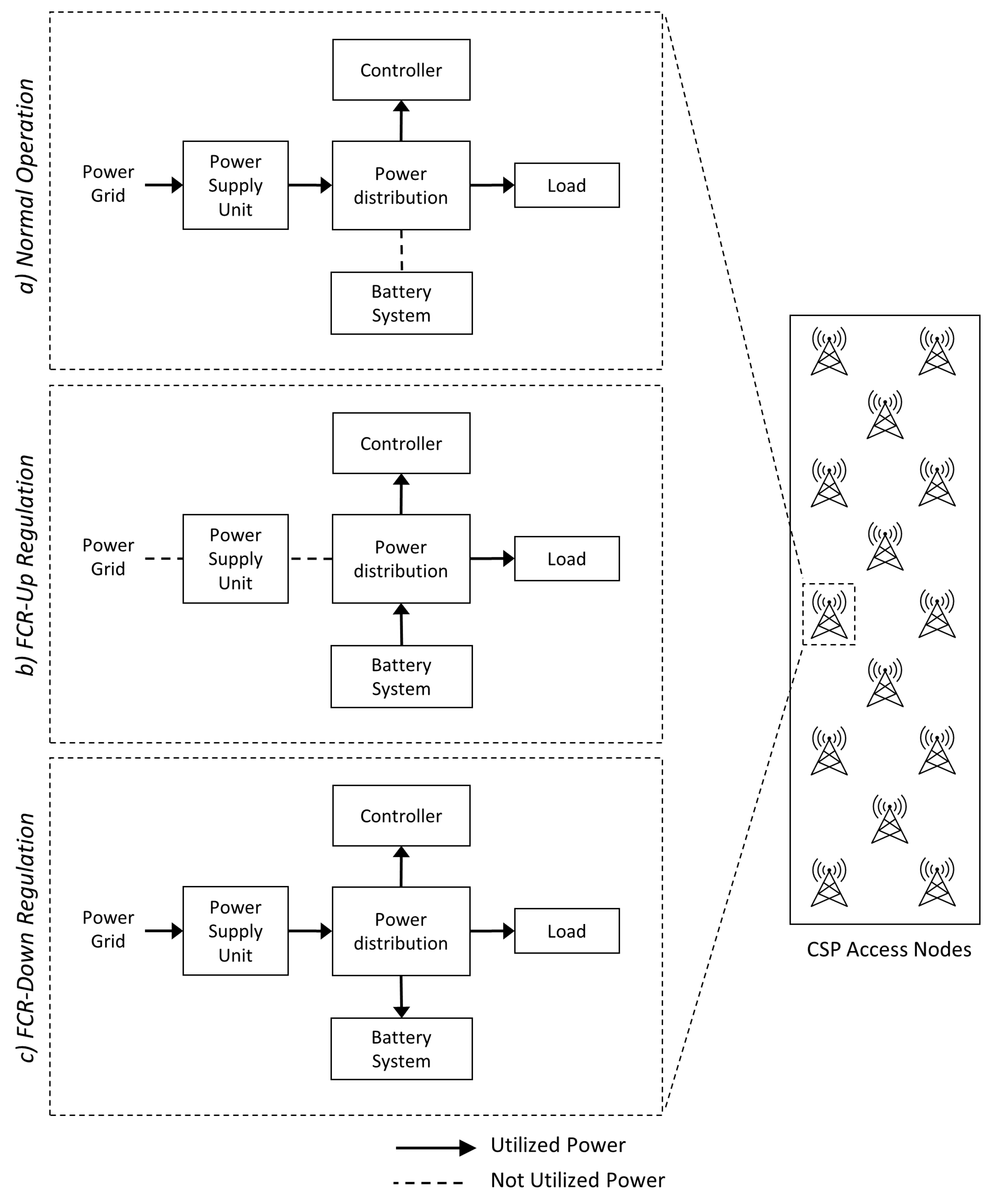
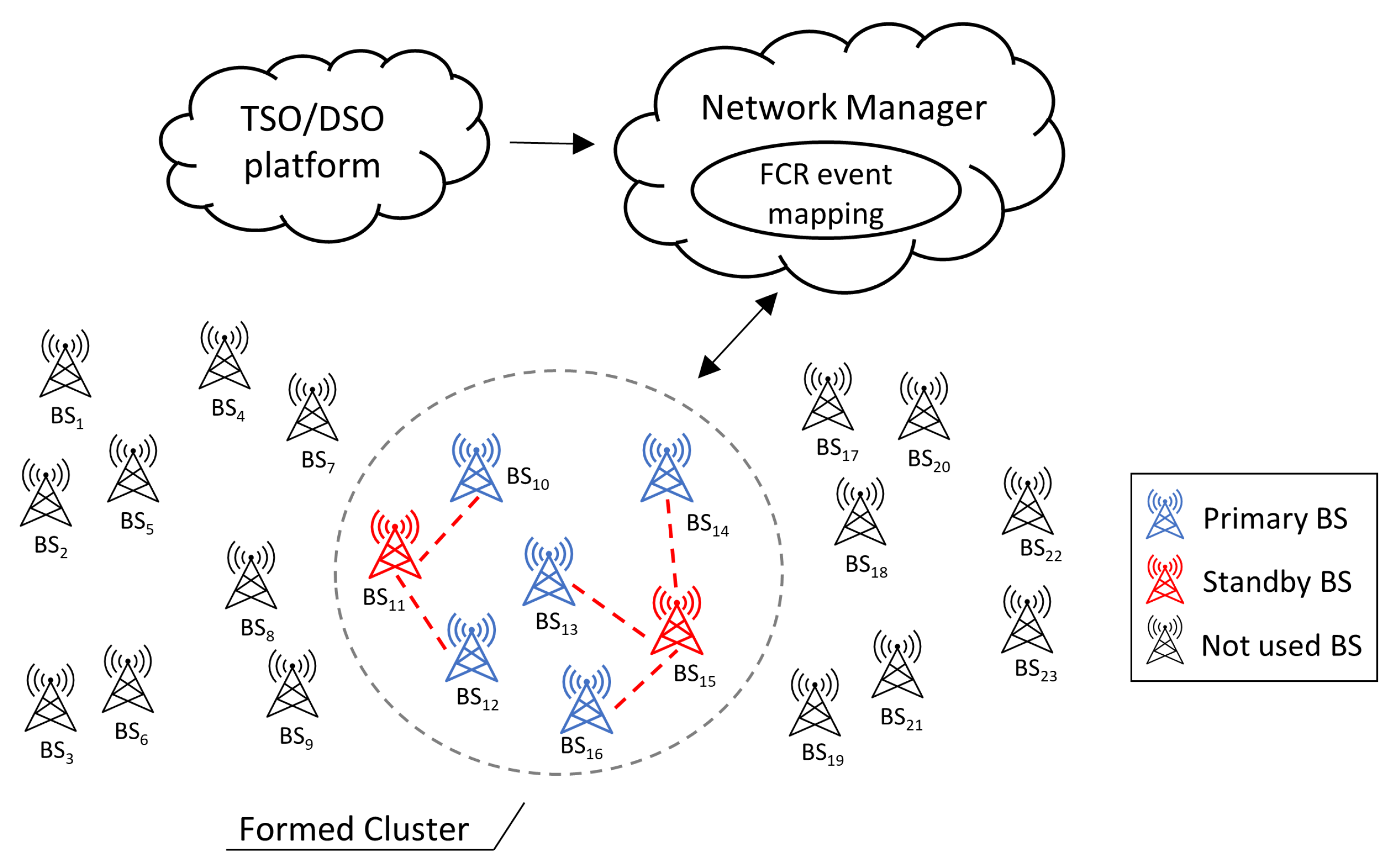
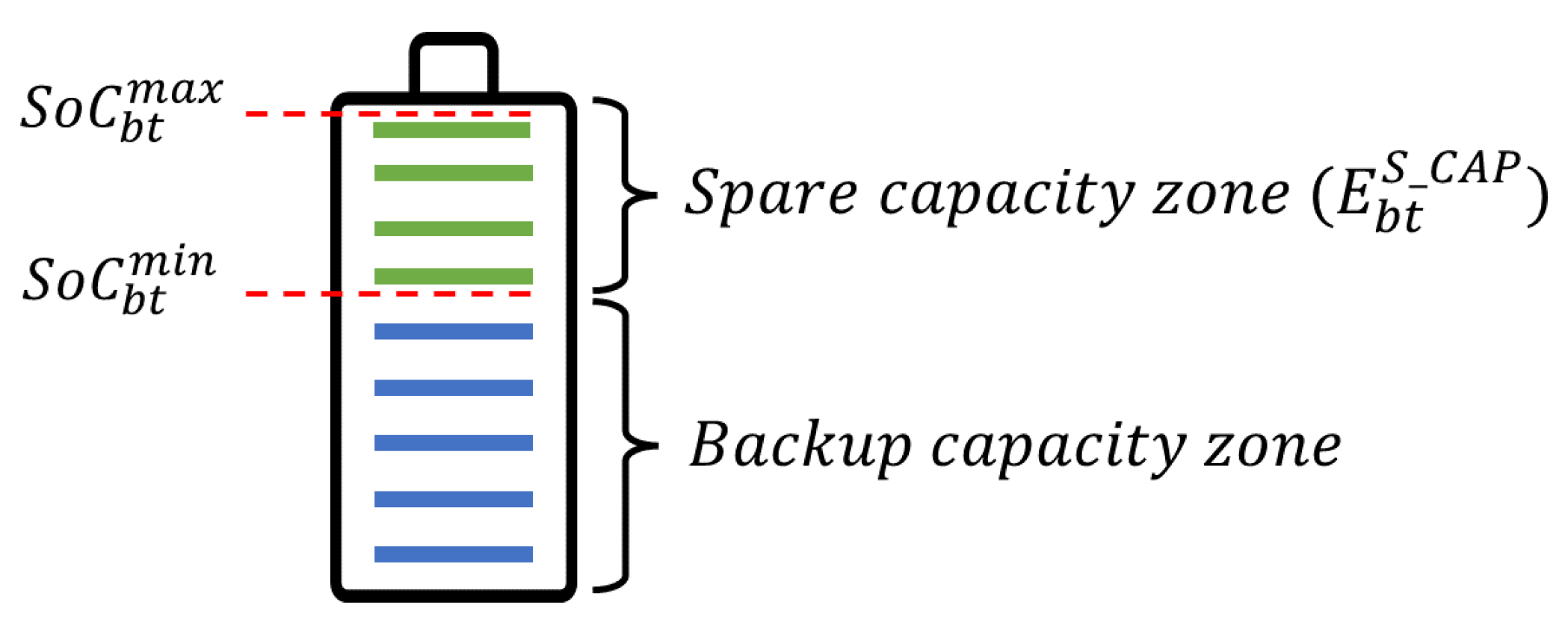
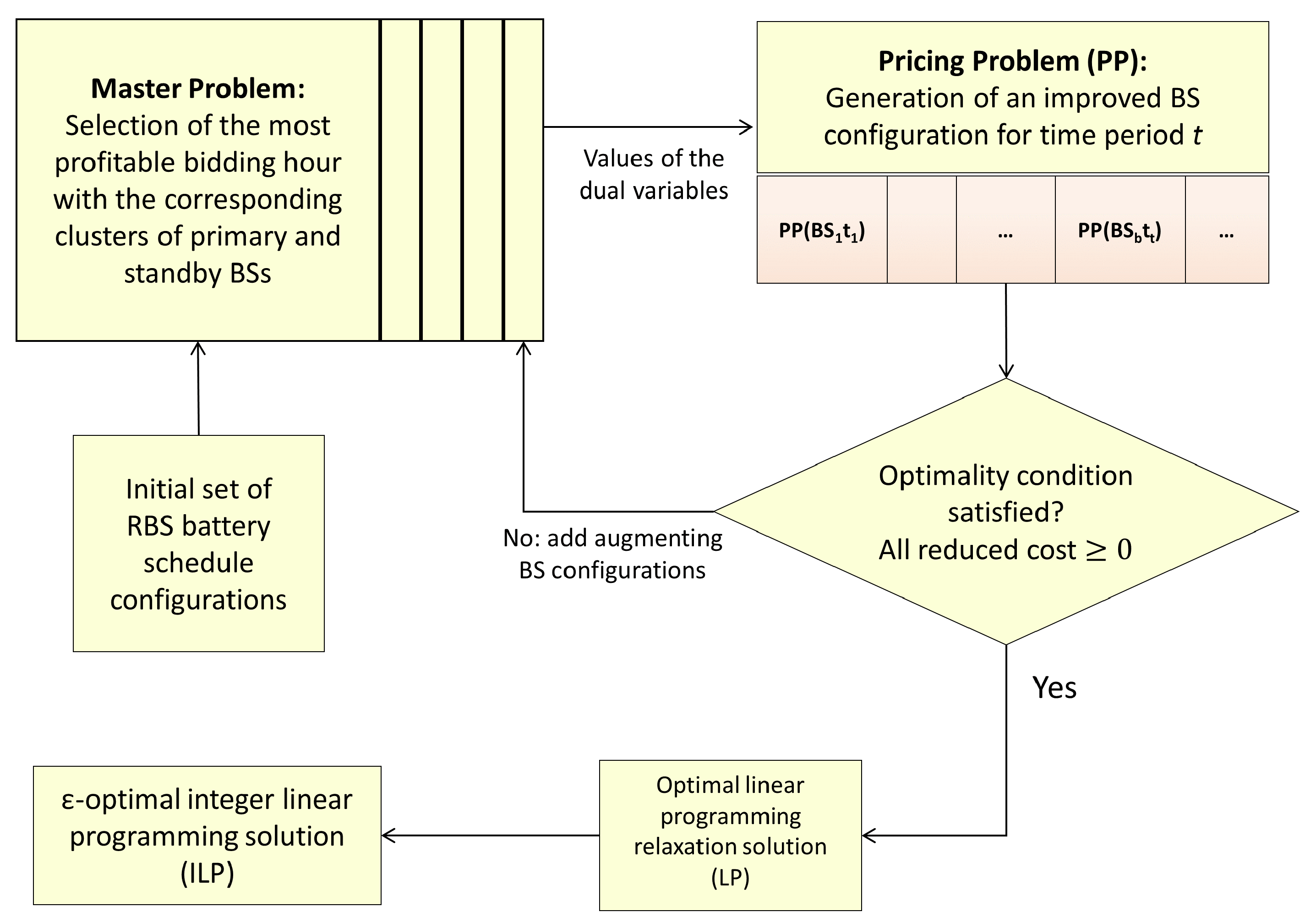

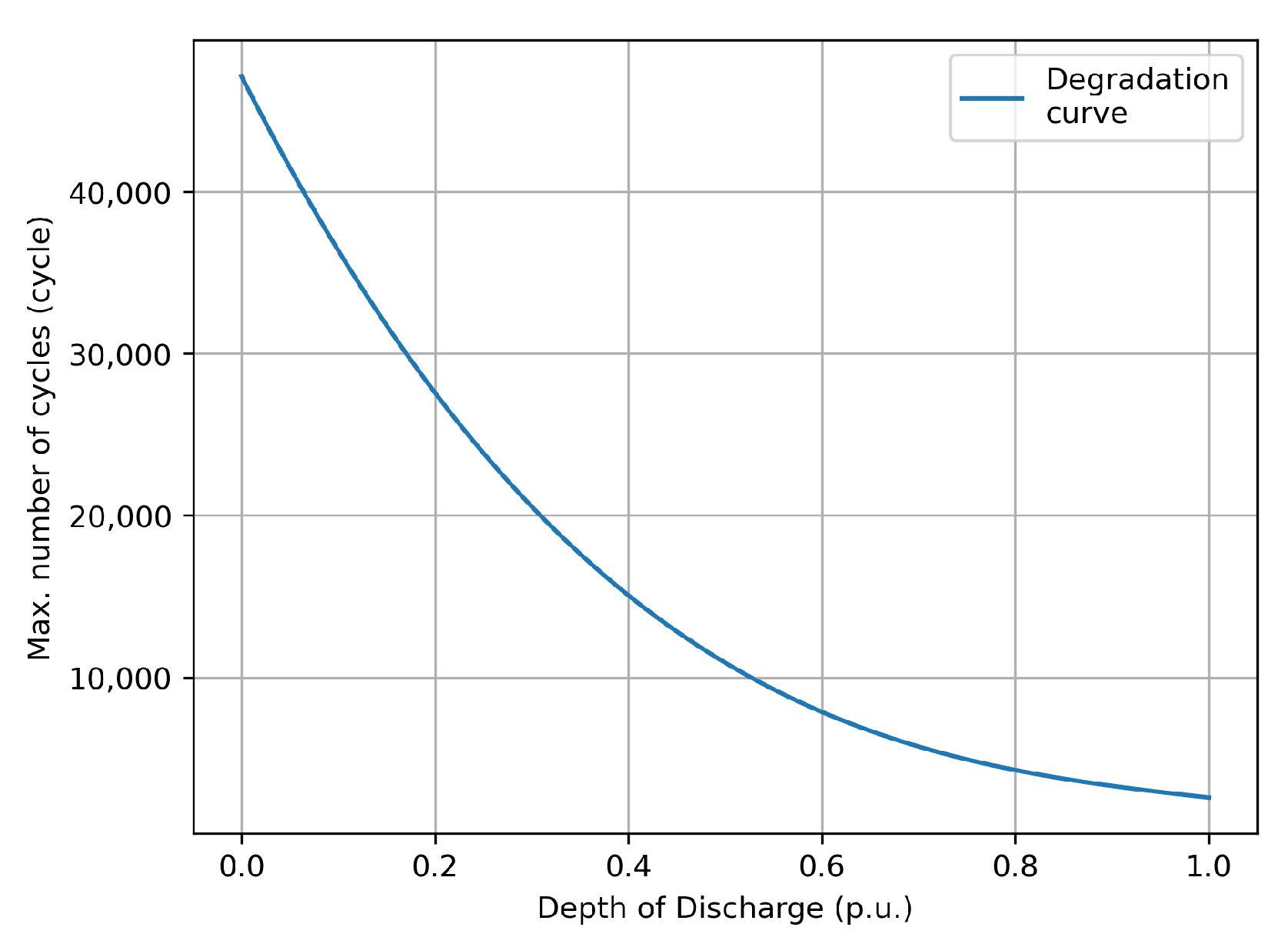
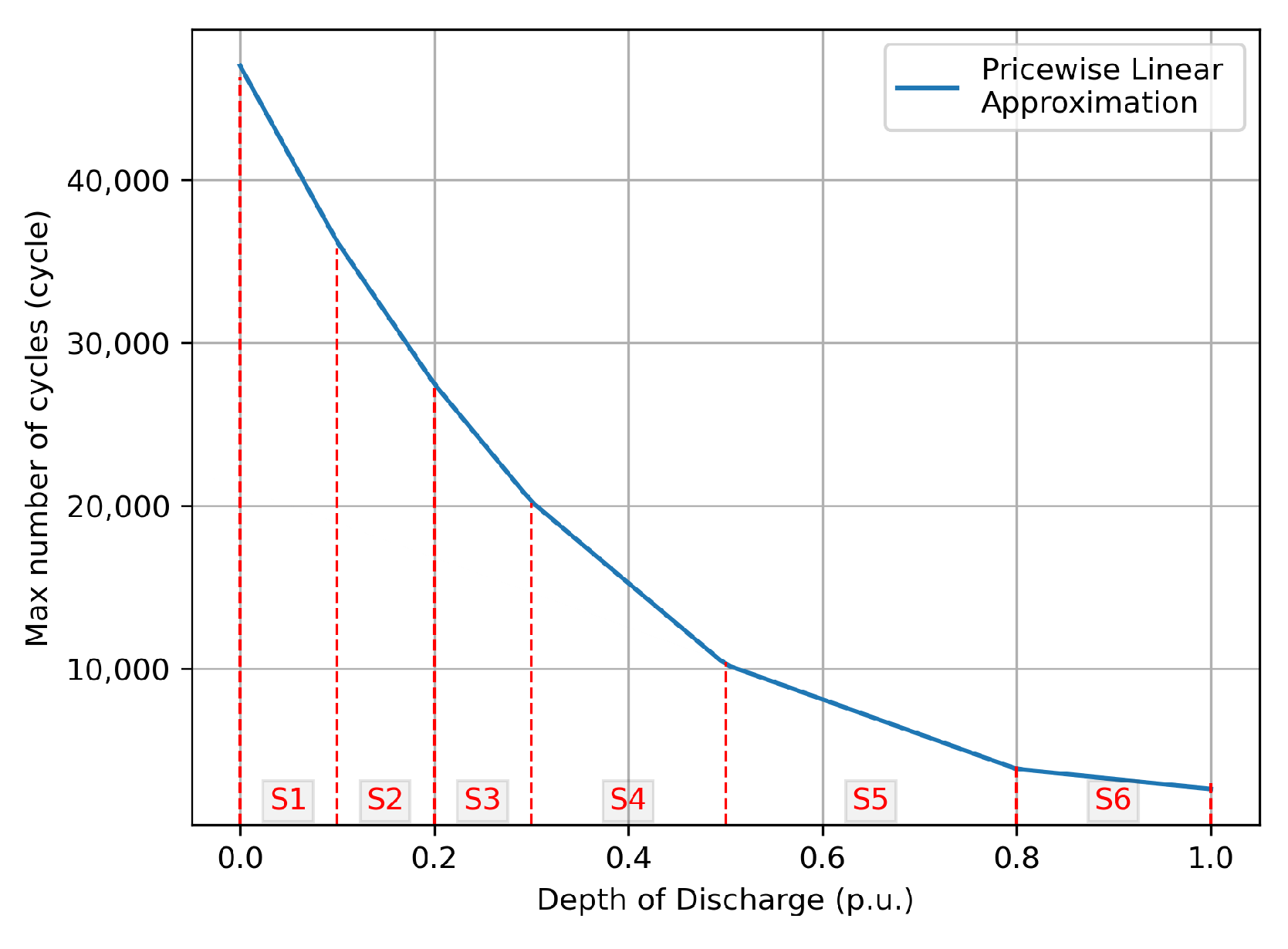
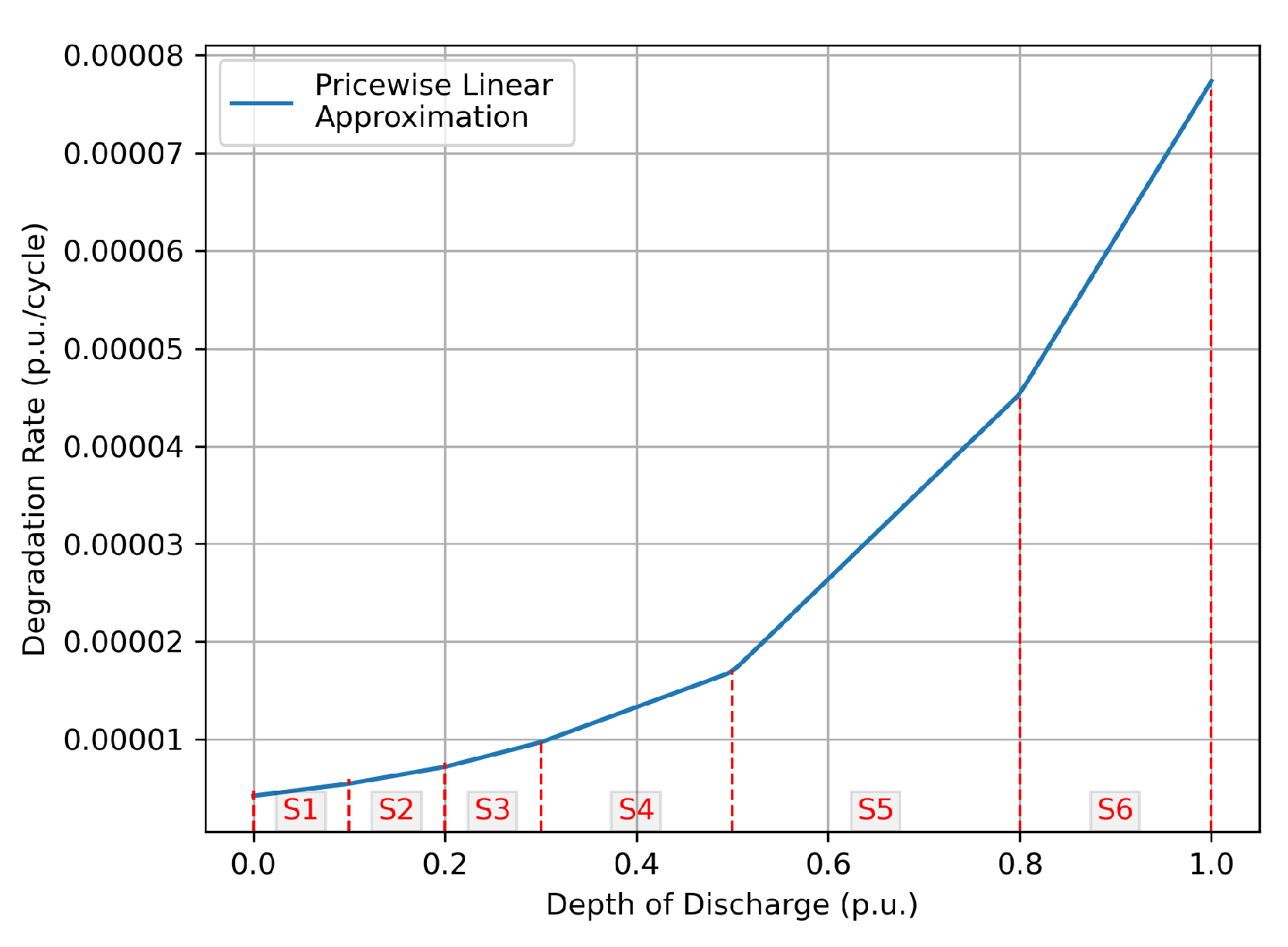


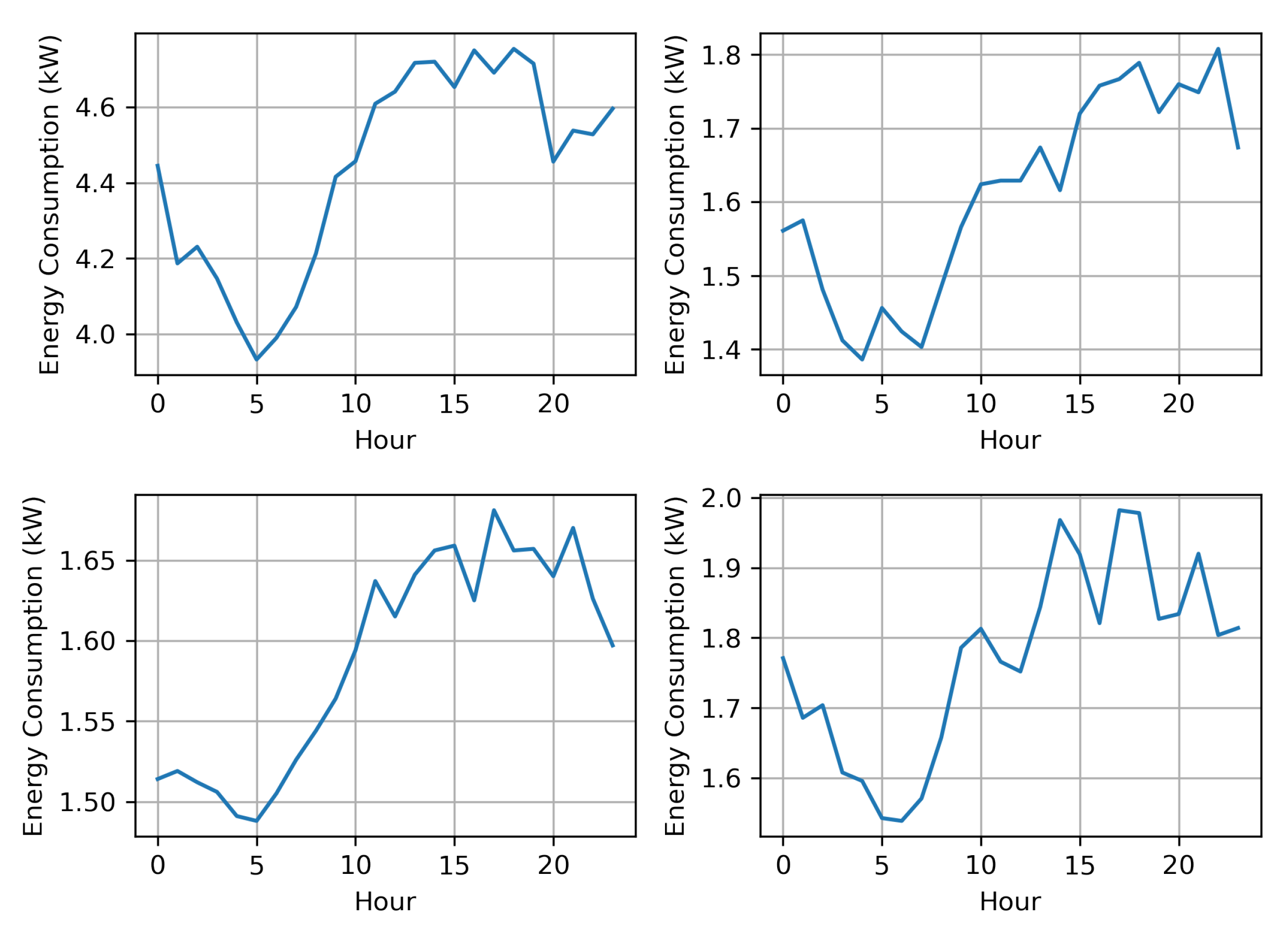
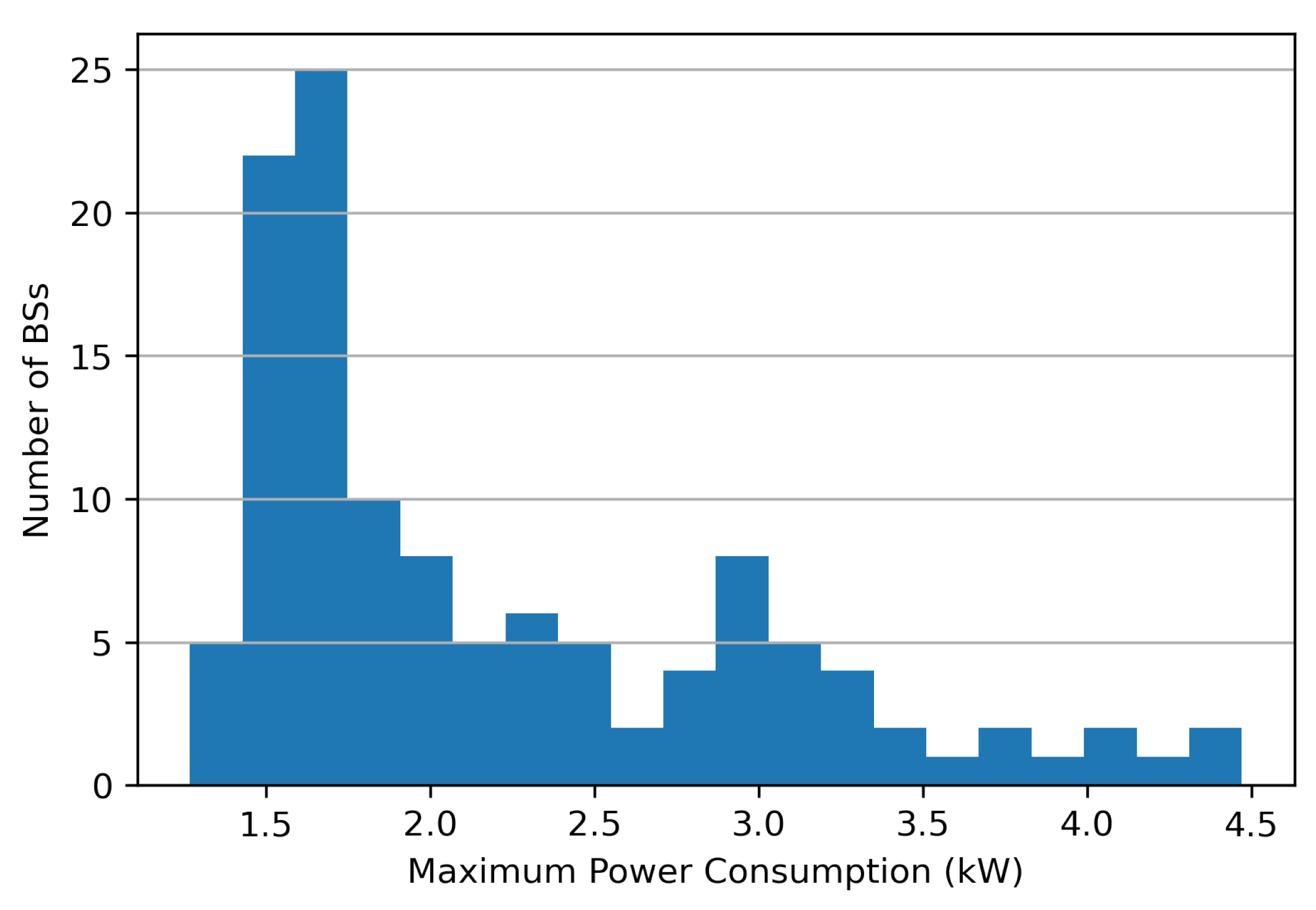

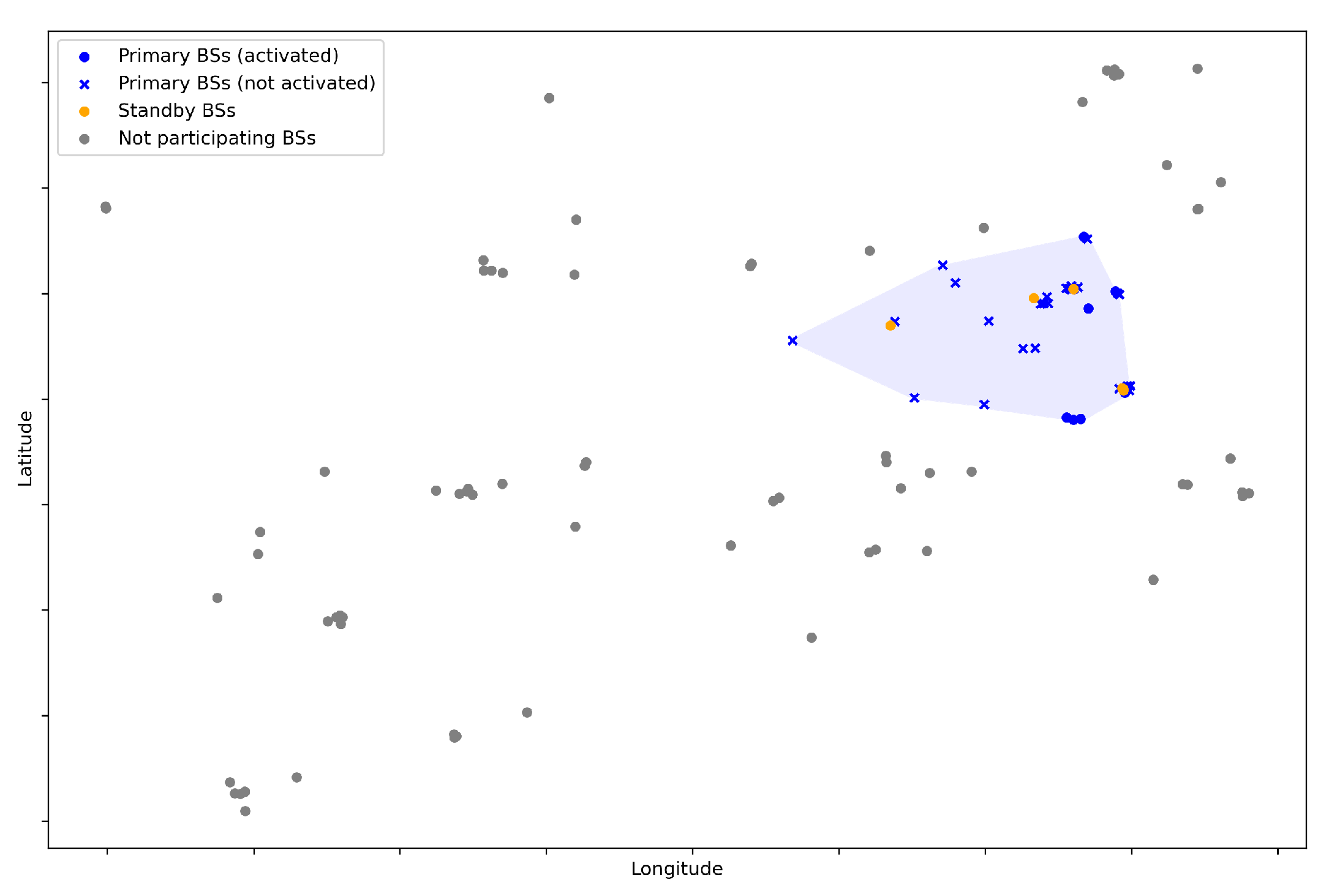
| FCR-N | FCR-D (up) | FCR-D (down) | |
|---|---|---|---|
| Minimum bid size | 0.1 MW | 0.1 MW | 0.1 MW |
| Activation frequency | deviations from 50.00 Hz | ≤49.90 Hz | ≥51.10 Hz |
| Maximum activation | ≤49.90 Hz (up) ≥50.10 Hz (down) | ≤49.50 Hz | ≥50.50 Hz |
| Activation Type | Automatic | Automatic | Automatic |
| Activation | 63%: 60 s | 50%: 5 s | 50%: 5 s |
| start-up time | 100%: 3 min | 100%: 30 s | 100%: 30 s |
| Volume in Sweden | ∼200 MW | ∼536 MW | ∼530 MW |
| Symmetric | Yes | No | No |
| Capacity (availability) payment | yes (pay-as-bid) | ||
| Energy | Yes (up-down | No | No |
| compensation | regulating price) | ||
| General | Approved prequalification; Real-time measurement | ||
| requirements | Electronic communication; Endurance | ||
| Year | FCR-N (EUR/MWh) | FCR-D Up (EUR/MWh) | FCR-D Down (EUR/MWh) |
|---|---|---|---|
| 2017 | 23.50 ± 14.29 | 7.42 ± 4.92 | - |
| 2018 | 38.51 ± 28.49 | 18.30 ± 18.84 | - |
| 2019 | 30.93 ± 16.94 | 22.38 ± 15.95 | - |
| 2020 | 17.04 ± 8.16 | 16.27 ± 7.42 | - |
| 2021 | 37.62 ± 20.83 | 44.88 ± 17.17 | - |
| 2022 | 58.76 ± 40.19 | 57.48 ± 39.39 | 23.79 ± 23.75 |
| Experiment | FCR Service | Bid Value | Selected Hour and Bid Price (USD/MW) | Requested Energy (Total) | Provided Energy (Total) | Missing Energy (%) | Capacity (Availability) Payment Profit | Energy Payment Profit | Battery Degrad. Cost | Cluster Power Capacity (Up/Down) | Cluster Energy Capacity (Up/Down) |
|---|---|---|---|---|---|---|---|---|---|---|---|
| Day one Winter (10/01/22) | FCR-N | 0.1 MW | 4 p.m. USD 53.69 | 31.93 kWh | 31.93 kWh | ∼0% | USD 5.36 | USD 1.71 | USD 0.14 | 0.1 MW/ 0.20 MW | 56.07 kWh/ 56.07 kWh |
| Day two Spring (10/04/22) | FCR-N | 0.1 MW | 6 a.m. USD 32.05 | 44.39 kWh | 44.39 kWh | ∼0% | USD 3.20 | USD 1.42 | USD 0.19 | 0.1 MW/ 0.23 MW | 78.17 kWh/ 78.17 kWh |
| Day three Summer (10/07/22) | FCR-N | 0.1 MW | 0 a.m. USD 86.68 | 22.78 kWh | 22.78 kWh | ∼0% | USD 8.66 | USD 1.97 | USD 0.1 | 0.1 MW/ 0.21 MW | 65.79 kWh/ 65.79 kWh |
| Experiment | FCR Service | Bid Value | Selected Hour and Bid Price (USD /MW) | Requested Energy (Total) | Provided Energy (Total) | Missing Energy (%) | Capacity (Availability) Payment Profit | Energy Payment Profit | Battery Degrad. Cost | Cluster Power Capacity (Up/Down) | Cluster Energy Capacity (Up/Down) |
|---|---|---|---|---|---|---|---|---|---|---|---|
| Day one Fall (08/10/21) | FCR-D 1 | 0.1 MW | 11 p.m. USD 58.82 | 0 kWh | 0 kWh | 0% | USD 5.88 | - | USD 0 | 0.1 MW/ 0.19 MW | 124.59 kWh/ 0 kWh |
| Day two Winter (25/01/22) | FCR-D 2 | 0.1 MW | 5 a.m. USD 10.38 | 0 kWh | 0 kWh | 0% | USD 1.03 | - | USD 0 | 0.04 MW/ 0.1 MW | 0 kWh/ 77.19 kWh |
Disclaimer/Publisher’s Note: The statements, opinions and data contained in all publications are solely those of the individual author(s) and contributor(s) and not of MDPI and/or the editor(s). MDPI and/or the editor(s) disclaim responsibility for any injury to people or property resulting from any ideas, methods, instructions or products referred to in the content. |
© 2024 by the authors. Licensee MDPI, Basel, Switzerland. This article is an open access article distributed under the terms and conditions of the Creative Commons Attribution (CC BY) license (https://creativecommons.org/licenses/by/4.0/).
Share and Cite
Dias, L.; Jaumard, B.; Eleftheriadis, L. Taking Advantage of Spare Battery Capacity in Cellular Networks to Provide Grid Frequency Regulation. Energies 2024, 17, 3775. https://doi.org/10.3390/en17153775
Dias L, Jaumard B, Eleftheriadis L. Taking Advantage of Spare Battery Capacity in Cellular Networks to Provide Grid Frequency Regulation. Energies. 2024; 17(15):3775. https://doi.org/10.3390/en17153775
Chicago/Turabian StyleDias, Leonardo, Brigitte Jaumard, and Lackis Eleftheriadis. 2024. "Taking Advantage of Spare Battery Capacity in Cellular Networks to Provide Grid Frequency Regulation" Energies 17, no. 15: 3775. https://doi.org/10.3390/en17153775
APA StyleDias, L., Jaumard, B., & Eleftheriadis, L. (2024). Taking Advantage of Spare Battery Capacity in Cellular Networks to Provide Grid Frequency Regulation. Energies, 17(15), 3775. https://doi.org/10.3390/en17153775






